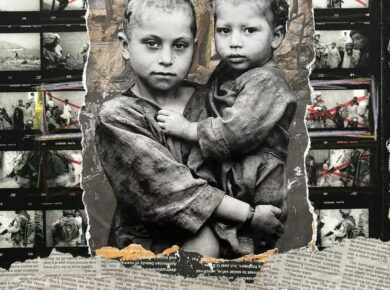Disclaimer:This blog post solely reflects the opinion of the authors and should not be taken to represent the general views of IPPR’s management/ editorial team or those of fellow authors.
To say social media is a medium for the expression of political opinions isn’t reveloratory. However, the value of social media – most notably TikTok – as tools for cultivating productive discussions on politics and the dissemination of news is evolving in such a way that it holds great potential for being a practical and influential source of information. While many are often quick to dismiss the platform as distracting, brain-rewiring, and fruitless, many are catching onto the influence TikTok holds as a platform for news delivery and debates.
Social media is often criticised – and rightly so – for its instrumental role in the level of political polarisation we’re seeing today. Facebook, for instance, is a prolific nurturer of the echo chambers and epistemic bubbles – networks of information that actively suppress certain perspectives, voices, and facts – and systematically feeds users what they want to hear, regardless of whether the information is reliable or not. The creation of these mentally isolating environments entrench people into their set of beliefs to a point where any foreign viewpoint is immediately met with contempt. What we see in these situations is what many call the backfire effect, where presenting people with information and statistics that contradict what they believe results in them shutting out different perspectives and doubling down on their beliefs rather than acknowledging them.
However, as a user of the app myself, I have increasingly noticed how the live video function has been used to promote a more open and welcoming environment for the discussion of contentious topics between people with opposing views. This is how it works: users begin a live video, place a background usually consisting of a screenshot of their notes app with bullet-pointed discussion prompts, invite other users as co-hosts and begin a conversation on their differing views while engaging with the live comments from other users listening in. Like any other social media platform nowadays, TikTok has developed an algorithm that trailers your feed to your personal interests and actively omits videos that would not fit into that category. While they do this to hook users into spending more time on the app, the end result is a dangerous information bubble that can be difficult to escape from. However, live videos seem to break this pattern. Rather than cocooning oneself into the comfort of our own epistemic bubble, these live videos help expose TikTok users to a new set of dialogues and opinions that would have otherwise been filtered out from their feed. If you are interacting with videos of users and topics on one side of the political spectrum, TikTok knows to feed you more content that resonates with these views and network of users. However, when people from this network join these live videos to debate others with different political opinions, as a result of your previous digital interactions with that person or realm of content from your end of the spectrum, TikTok will recommend that live video to you. That live video popping up on your newsfeed – or as it is called on TikTok, your ‘For You Page’ – is an opportunity to break out of your bubble and listen to other perspectives. This format of being exposed to outside information and arguments does not risk having a ‘backfire effect’ as much as just shoving information into somebody’s face would, because as first hand witnesses to open-minded discussions – which, crucially, include your own views – between ordinary people, users are able to absorb more without as much resistance. The difference here is that this space is fostering a productive and, most importantly, multifaceted dialogue through the open communication between regular TikTok users and not just antagonising others with facts that contradict their beliefs.
Live video debate between multiple users. (Photo: TikTok, @earth2abbs2, 15th February 2022) https://www.tiktok.com
It is particularly noteworthy that both the users conducting these live videos and the audiences they are reaching are particularly young, as TikToks main users range from teenagers to young adults. This is where we can begin to sense the tangible value of TikTok as a platform that goes beyond viral 15 second dance challenges, travel montages and dog videos. We know that the average teenager and young adult isn’t logging into websites like BBC news on a daily basis, nor are they voluntarily going out of their way to stay informed about current events. The average news viewer in the UK in 2020 was 65+, with a steady decline in viewer percentage as age decreased, so we know that both the content and delivery of information is not being tailored for and directed towards today’s youth. With its largest age group in the UK ranging from 18-24 years of age, making up 26% of its users in 2021, TikTok has the potential to fill in this gap and already has promising examples of doing so.
Digital news websites are rushing to extend their platforms onto the app, with industry titans like Bloomberg and Sky News reformatting their content production to fit in with the new dynamics of news delivery. On top of her work as a BBC journalist and broadcaster, Victoria Derbyshire has brought her reporting to TikTok as well, posting broadcast style videos on breaking stories and current events on a regular basis, garnering views from a range of tens of thousands to millions per video and amassing 354.2k followers and a total of 4.5M likes as of February 2022. This style of content is reaching an audience that both televised and digital print media have historically not focused on. It has the potential to make current events and important dialogues being held on these issues more accessible and digestible to the average teenager scrolling through their ‘For You Page’.
The recent Russian invasion of Ukraine has also shed light on the power of social media apps like TikTok in terms of spreading awareness, information, and personal experiences all in real-time. Videos and TikTok lives showing crowded underground train stations turned bomb shelters, citizens showing intimate details of these dire situations and pleading for help, people spreading survival tips and what to bring to bunkers, and even live updates from Ukranians still outdoors in their cities are all examples of the vital content being shared on the app. Users are able to witness first-hand the suffering and experiences of the Ukrainian people coming from the citizens themselves, something that is arguably far more raw and informative than the filtered accounts from news outlets. TikTok allows these victims of aggression to show the world what they want you to see and not just what the media chooses to report on.
This is not to say that this type of content, paired with the demographic being exposed to it, does not have its dangers. While the largest user age group ranges from 18 to 24 in the UK, the minimum sign up age on the app is only 13. To them, access to this app should be given at an adults’ discretion with parental controls if deemed necessary and has to be evaluated on a case-by-case basis, but this does not diminish the app’s value as a tool for informing younger audiences. I also cannot ignore the threat of the spread of both misinformation and disinformation that has come with the arrival of the digital age, but this is an issue that concerns all news outlets and not just social media.
To dismiss TikTok because of its novelty and one’s personal misconceptions and unfamiliarity with it would be to overlook an ingenious opportunity to revolutionise the style of news delivery, close the door to a new realm of fresh content, and sever attempts to reach out and engage younger audiences. The climate of news delivery is shifting, and the demand for this among the younger demographic is clear.
By Rafaela Ganzer
Rafaela is a second year PIR student from Brazil with a passion for journalism and current events.







